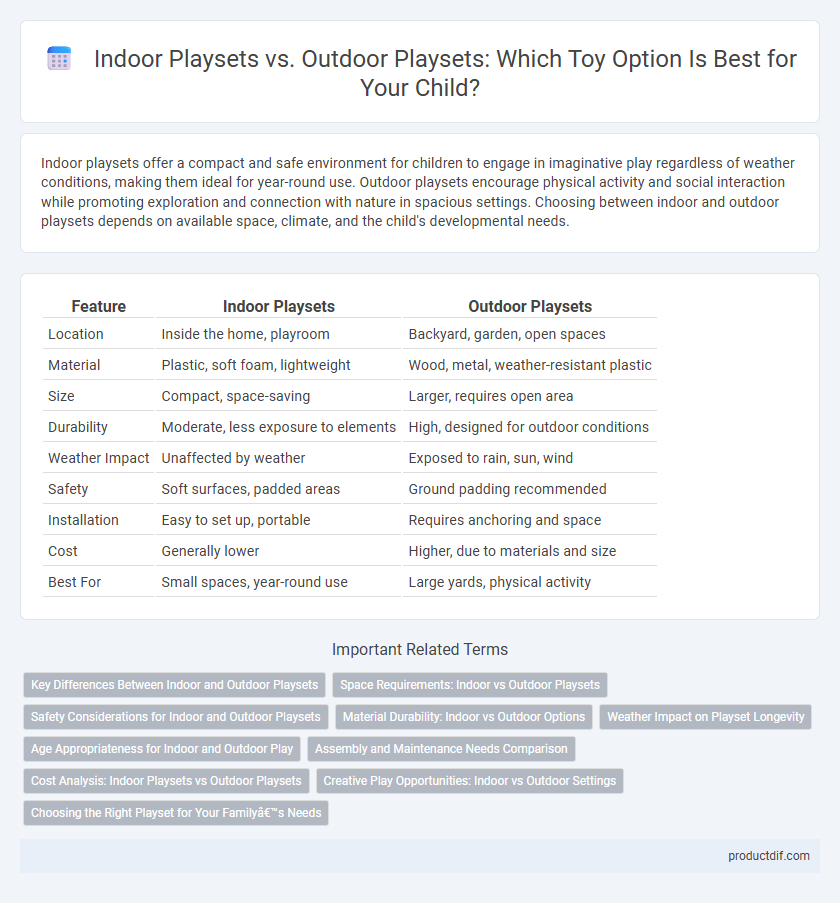Indoor playsets offer a compact and safe environment for children to engage in imaginative play regardless of weather conditions, making them ideal for year-round use. Outdoor playsets encourage physical activity and social interaction while promoting exploration and connection with nature in spacious settings. Choosing between indoor and outdoor playsets depends on available space, climate, and the child's developmental needs.
Table of Comparison
| Feature | Indoor Playsets | Outdoor Playsets |
|---|---|---|
| Location | Inside the home, playroom | Backyard, garden, open spaces |
| Material | Plastic, soft foam, lightweight | Wood, metal, weather-resistant plastic |
| Size | Compact, space-saving | Larger, requires open area |
| Durability | Moderate, less exposure to elements | High, designed for outdoor conditions |
| Weather Impact | Unaffected by weather | Exposed to rain, sun, wind |
| Safety | Soft surfaces, padded areas | Ground padding recommended |
| Installation | Easy to set up, portable | Requires anchoring and space |
| Cost | Generally lower | Higher, due to materials and size |
| Best For | Small spaces, year-round use | Large yards, physical activity |
Key Differences Between Indoor and Outdoor Playsets
Indoor playsets are designed with compact dimensions and lightweight materials suitable for confined spaces, often incorporating soft surfaces and vibrant colors to ensure safety and stimulate creativity. Outdoor playsets feature durable, weather-resistant materials like treated wood or metal to withstand environmental elements, and typically include larger structures such as swings, slides, and climbing frames. The key differences between indoor and outdoor playsets lie in their size, material resilience, and safety features adapted to the respective environments.
Space Requirements: Indoor vs Outdoor Playsets
Indoor playsets typically require compact designs that fit within smaller living spaces, making them ideal for apartments or homes with limited room. Outdoor playsets benefit from larger open areas for safe installation, allowing for expansive structures like swing sets and climbing frames. Proper measurement of available space ensures safety and maximizes the play experience in both indoor and outdoor environments.
Safety Considerations for Indoor and Outdoor Playsets
Indoor playsets typically require padded flooring and lower height structures to minimize injury risks in confined spaces, while outdoor playsets demand weather-resistant materials and secure anchoring to withstand environmental elements and ensure stability. Proper supervision and regular maintenance checks are crucial for both types to prevent accidents and maintain safety standards. Selecting age-appropriate equipment with non-toxic finishes further enhances safety for children during play.
Material Durability: Indoor vs Outdoor Options
Indoor playsets typically use lightweight, non-toxic plastic or wood designed for smooth surfaces and controlled environments, ensuring safety and comfort but with limited resistance to wear and tear. Outdoor playsets feature robust materials such as treated wood, metal, or high-density polyethylene, engineered to withstand weather elements like rain, UV rays, and temperature fluctuations for long-lasting durability. Choosing the right material based on play environment significantly impacts the lifespan and maintenance requirements of the playset.
Weather Impact on Playset Longevity
Indoor playsets benefit from protection against weather elements, significantly extending their lifespan compared to outdoor playsets exposed to rain, sunlight, and temperature fluctuations. UV rays can cause fading and material degradation in outdoor playsets, while moisture leads to rust and wood rot if not properly maintained. Choosing weather-resistant materials like treated wood or durable plastics improves outdoor playset durability, but indoor play areas ensure consistent preservation regardless of seasonal changes.
Age Appropriateness for Indoor and Outdoor Play
Indoor playsets are typically designed for younger children aged 1 to 5 years, featuring soft materials and compact designs suitable for limited spaces, ensuring safety and age-appropriate stimulation. Outdoor playsets often accommodate a broader age range, from toddlers to preteens, with durable materials and larger structures that promote physical activity and coordination in an open environment. Selecting the right playset based on age appropriateness involves considering safety standards, size limitations, and developmental benefits tailored to indoor or outdoor use.
Assembly and Maintenance Needs Comparison
Indoor playsets typically require simpler assembly due to their compact design and lightweight materials, making setup faster and less labor-intensive compared to outdoor playsets. Outdoor playsets often involve more complex installation processes, including anchoring to the ground for stability and using weather-resistant materials that demand regular maintenance such as cleaning, sealing, or repainting to prevent wear from elements. Choosing between indoor and outdoor playsets depends on the user's willingness to engage in ongoing upkeep and the importance of ease of assembly for their specific environment.
Cost Analysis: Indoor Playsets vs Outdoor Playsets
Indoor playsets typically cost between $150 and $600, offering compact designs suited for limited spaces, while outdoor playsets range from $300 to over $3,000 due to larger, weather-resistant structures and installation fees. Maintenance expenses are generally lower for indoor playsets, as they avoid weather-related wear and tear common in outdoor sets requiring regular treatment or repairs. Cost-effectiveness depends on available space, durability needs, and long-term usage, with indoor options favoring budget-conscious families and outdoor sets appealing to those investing in lasting backyard entertainment.
Creative Play Opportunities: Indoor vs Outdoor Settings
Indoor playsets offer creative play opportunities through interactive features like climbing walls, slides, and sensory panels that encourage imaginative role-playing and fine motor skills development. Outdoor playsets expand creative possibilities by incorporating natural elements such as sandboxes, swing sets, and open spaces for running, promoting physical activity and social interaction. Both settings stimulate creativity, but outdoor playsets uniquely combine environmental exploration with imaginative scenarios.
Choosing the Right Playset for Your Family’s Needs
Indoor playsets offer compact, weather-resistant options ideal for limited spaces and year-round use, featuring soft materials and interactive elements that enhance safety and sensory development. Outdoor playsets provide larger, durable structures such as swings, slides, and climbing frames, promoting physical activity and social interaction in natural surroundings. Evaluating factors like available space, climate, safety preferences, and children's age ensures selecting a playset that aligns with your family's lifestyle and developmental goals.
Indoor playsets vs outdoor playsets Infographic

 productdif.com
productdif.com